
contributed by The Folks at Fiber-Seal
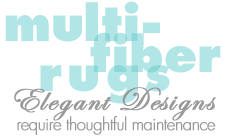
The vast majority of area rugs are created using a single type of face fiber. Orientals and similar rugs may contain cotton yarns in their foundation, but the pile is almost always a single fiber type. In the last few years, there has been a new emphasis on rugs created with pile elements of two or more different fibers. For lack of a better term, we simply call these “multi-fiber” rugs, and with multiple fibers come multiple maintenance considerations required for long-term use.
Easy Does It
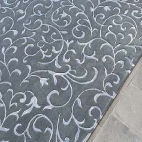 Multi-fiber rugs can utilize virtually any combination of fibers. Most of these rugs use wool as the dominant (ground) yarn and then build designs from one or (less frequently) two other fibers such as silk, rayon, linen, hemp, etc. Many of these rugs are found in contemporary designs, such as the one shown in the photo.
Multi-fiber rugs can utilize virtually any combination of fibers. Most of these rugs use wool as the dominant (ground) yarn and then build designs from one or (less frequently) two other fibers such as silk, rayon, linen, hemp, etc. Many of these rugs are found in contemporary designs, such as the one shown in the photo.
Regardless of the combination used, there is one primary rule when caring for these rugs: Anytime more than one fiber is used, the maintenance of the rug should be governed by the weaker fiber.
Different Fibers = Different Characteristics
Let’s examine the most common fibers used in these rugs and talk a little about their performance:
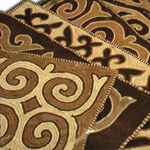 WOOL
WOOL
Wool has been used for centuries as a floor covering, in part because of its outstanding resiliency. It is very resistant to crushing or matting. Wool is also known for its soil- hiding properties and cleanability. When cared for properly, these rugs can last a lifetime.
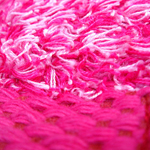 RAYON
RAYON
Rayon is at least 50% weaker when wet and has very poor resiliency. It also shrinks and rings easily and tends to show soil readily. Generally, these fibers should be dry cleaned. If water-based cleaners are used, they must be applied sparingly and carefully to avoid damaging the fiber. Overall, rayon fibers do not clean well, especially with ground-in soils often seen in floor coverings.
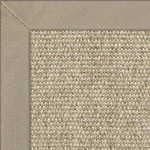 LINEN, COTTON, HEMP
LINEN, COTTON, HEMP
Here, we are talking about all of the natural cellulosic fibers. These fibers have no resiliency and will tend to crush and mat. They do not have any soil-hiding properties. On the plus side, they are stronger when wet, so they can generally be cleaned using both wet and dry cleaning methods. Like rayon, ground-in soils are difficult to remove from these fibers.
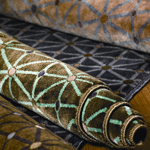 SILK
SILK
The resiliency of silk is good when the fiber is dry. It can generally be wet cleaned or dry cleaned. Like wool, it is slightly weaker when wet and mechanical cleaning must be done with caution. Silk generally cleans well.
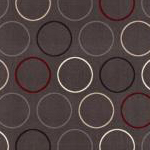 NYLON, POLYESTER, ACRYLIC
NYLON, POLYESTER, ACRYLIC
These fibers tend to be good soil-hiders and generally clean well. Nylon is typically more resilient than other synthetic fibers.
What Happens When Fibers Are Combined”
If wool yarn is used as the ground and a rayon yarn is inserted as a design element, what’s the problem”
The short answer is: Plenty. The wool that can last a lifetime will continue to do that. The rayon fiber will not. The design will fade or distort as the weaker rayon fiber starts to crush. Nap distortion will become prevalent in traffic lanes. If a water based spill — wine, coffee, soda, etc. — should happen, or if soiling gets to a point that cleaning is needed, the chances of correction are minimal because the rug must be cleaned as if it is made of rayon.
A better fiber combination is wool and silk, because their properties are the most similar to each other.
Simply Stated
Cellulosic fibers like cotton, linen, hemp, etc., and man-made cellulosic fibers such as rayon cannot withstand the punishment that most floor coverings receive. In pile constructions, they cannot stand alone, nor do they do well when combined with other fibers.
Dyes…One More Potential Problem
Dyes are always a concern when cleaning, but with multi- fiber rugs it can be an even bigger problem.
Wool yarns tend to be fast to water-based cleaning. Rayon usually shows good colorfastness as well. However, dark silks and natural cellulosics are often suspect. Of course, professional rug cleaners will test very carefully for colorfastness, especially when dark colors are present.
The Bottom Line
If there were a rating system it would look something like this.
1 | Wool with nylon: Very good, but not as visually interesting.
2 | Wool with silk: Good, but dyes could be an issue.
3 | Wool with cellulosics: Fair, but crushing and dyes could be problems.
4 | Wool with rayon: Poor. Crushing and nap distortion will be overriding issues.
The Aftercare Pros!
 Got a question about a fabric or floor covering” We are happy to answer it for you. Trust Fiber-Seal to provide the latest information about elegant interior textiles and their care. This article first appeared in Fiber-Seal System’s FIBERFAX Volume Twenty | Number One. Copyright © 2010 by Fiber-Seal Systems. All rights reserved.
Got a question about a fabric or floor covering” We are happy to answer it for you. Trust Fiber-Seal to provide the latest information about elegant interior textiles and their care. This article first appeared in Fiber-Seal System’s FIBERFAX Volume Twenty | Number One. Copyright © 2010 by Fiber-Seal Systems. All rights reserved.


